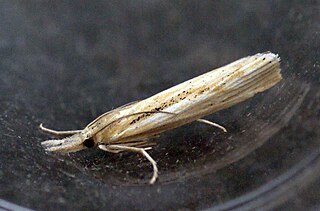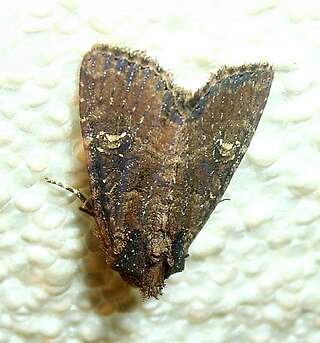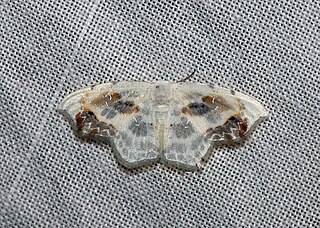
Apamea monoglypha, the dark arches, is a moth of the family Noctuidae. The species was first described by Johann Siegfried Hufnagel in 1766. It is a common, sometimes abundant, European species. It is found in most of Europe except northernmost Fennoscandia and the southern parts of the Iberian Peninsula and Greece. The species is also found in Anatolia, Turkestan, Western Asia and Central Asia, Siberia and Mongolia. In the Alps it is found up to heights of 2,500 meters. The smaller subspecies sardoa is found on Sardinia and Corsica.

Apamea remissa, the dusky brocade, is a species of moth of the family Noctuidae. It is distributed throughout Europe and Turkey, ranging across the Palearctic realm to Siberia, Manchuria and Japan. It has also been reported from Alaska.

Appias lalage, the spot puffin, is a small butterfly of the family Pieridae, that is, the yellows and whites, which is found in India, Indochina and Hainan.

Pediasia aridella is a species of moth of the family Crambidae. It was described by Carl Peter Thunberg in 1788 and is found in Europe. There are three recognised subspecies.

The Early Grey(Xylocampa areola) is a species of moth of the family Noctuidae. It is found in Europe and Morocco.

Xanthia gilvago, the dusky-lemon sallow, is a moth of the family Noctuidae. The species was first described by Michael Denis and Ignaz Schiffermüller in 1775. It is found in Europe.
Dipriodonta is a monotypic genus of moths belonging to the subfamily Drepaninae and contains Dipriodonta sericea as only species, which is found in India.

Apamea unanimis, the small clouded brindle, is a moth of the family Noctuidae. The species was first described by Jacob Hübner in 1813. It is native to Europe, Turkey, Azerbaijan, and western Siberia. It has been introduced in North America and can now be found in Ontario, Quebec, New Brunswick, New York, Michigan, and Wisconsin.

Grammodes stolida, the geometrician, is a moth of the family Erebidae. The species was first described by Johan Christian Fabricius in 1775. It is found in Africa, southern Europe, most of Asia and Australia. It migrates to central and northern Europe as far north as England, Denmark and Finland.

The double-spot brocade is a species of moth of the family Noctuidae. It is found in most of Europe, in Turkey and the west of Iran. In Anatolia it is represented by the subspecies Meganephria bimaculosa pontica.
Drapetodes interlineata is a moth in the family Drepanidae. It was described by Warren in 1896. It is found in Singapore, on Peninsular Malaya and in Indonesia (Java).

Leucoblepsis renifera is a moth in the family Drepanidae. It was described by Warren in 1900. It is found on Peninsular Malaysia, Sumatra and Borneo.
Nordstromia humerata is a moth in the family Drepanidae. It was described by Warren in 1896. It is found in north-eastern India.
Oreta bicolor is a moth in the family Drepanidae. It was described by William Warren in 1897. It is found in Sundaland and Malaysia.
Phalacra albilinea is a moth in the family Drepanidae. It was described by Warren in 1899. It is found in India.
Stenoma anetodes is a moth of the family Depressariidae. It is found in Guyana.
Stenoma platyterma is a moth of the family Depressariidae. It is found in Guyana.
Psittacastis stigmaphylli is a moth in the family Depressariidae. It was described by Lord Walsingham in 1912. It is found on Jamaica.

Udea albostriata is a moth in the family Crambidae. It was first described by Zhang and Li in 2016. It is found in Hebei, China.
Antaeotricha praerupta is a moth in the family Depressariidae. It was described by Edward Meyrick in 1915. It is found in Guyana.










